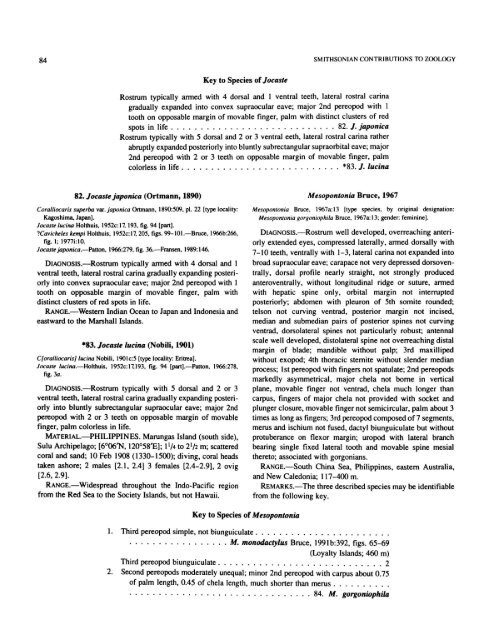SMITHSONIAN CONTRIBUTIONS TO ZOOLOGY • NUMBER 543 ...
SMITHSONIAN CONTRIBUTIONS TO ZOOLOGY • NUMBER 543 ...
SMITHSONIAN CONTRIBUTIONS TO ZOOLOGY • NUMBER 543 ...
You also want an ePaper? Increase the reach of your titles
YUMPU automatically turns print PDFs into web optimized ePapers that Google loves.
84<br />
Key to Species of Jocaste<br />
<strong>SMITHSONIAN</strong> <strong>CONTRIBUTIONS</strong> <strong>TO</strong> <strong>ZOOLOGY</strong><br />
Rostrum typically armed with 4 dorsal and 1 ventral teeth, lateral rostral carina<br />
gradually expanded into convex supraocular eave; major 2nd pereopod with 1<br />
tooth on opposable margin of movable finger, palm with distinct clusters of red<br />
spots in life 82. J. japonica<br />
Rostrum typically with 5 dorsal and 2 or 3 ventral eeth, lateral rostral carina rather<br />
abruptly expanded posteriorly into bluntly subrectangular supraorbital eave; major<br />
2nd pereopod with 2 or 3 teeth on opposable margin of movable finger, palm<br />
colorless in life *83. J. lucina<br />
82. Jocaste japonica (Ortmann, 1890)<br />
Coralliocaris superba var. japonica Ortmann, 1890:509, pi. 22 [type locality:<br />
Kagoshima, Japan].<br />
Jocaste lucina Holthuis, 1952c:17, 193, fig. 94 [part].<br />
ICavicheles kempi Holthuis, 1952c: 17, 205, figs. 99-101.—Bruce, 1966b:266,<br />
fig. 1; 1977i:10.<br />
Jocaste japonica.—Patton, 1966:279, fig. 36.—Fransen, 1989:146.<br />
DIAGNOSIS.—Rostrum typically armed with 4 dorsal and 1<br />
ventral teeth, lateral rostral carina gradually expanding posteriorly<br />
into convex supraocular eave; major 2nd pereopod with 1<br />
tooth on opposable margin of movable finger, palm with<br />
distinct clusters of red spots in life.<br />
RANGE.—Western Indian Ocean to Japan and Indonesia and<br />
eastward to the Marshall Islands.<br />
*83. Jocaste lucina (Nobili, 1901)<br />
Cforalliocaris] lucina Nobili, 1901c:5 [type locality: Eritrea].<br />
Jocaste lucina.—Holthuis, 1952c:17,193, fig. 94 [part].—Patton, 1966:278,<br />
fig. 2a.<br />
DIAGNOSIS.—Rostrum typically with 5 dorsal and 2 or 3<br />
ventral teeth, lateral rostral carina gradually expanding posteriorly<br />
into bluntly subrectangular supraocular eave; major 2nd<br />
pereopod with 2 or 3 teeth on opposable margin of movable<br />
finger, palm colorless in life.<br />
MATERIAL.—PHILIPPINES. Marungas Island (south side),<br />
Sulu Archipelago; [6°06'N, 120°58'E]; l'A to 2V2 m; scattered<br />
coral and sand; 10 Feb 1908 (1330-1500); diving, coral heads<br />
taken ashore; 2 males [2.1, 2.4] 3 females [2.4-2.9], 2 ovig<br />
[2.6, 2.9].<br />
RANGE.—Widespread throughout the Indo-Pacific region<br />
from the Red Sea to the Society Islands, but not Hawaii.<br />
2.<br />
Key to Species of Mesopontonia<br />
Mesopontonia Bruce, 1967<br />
Mesopontonia Bruce, 1967a: 13 [type species, by original designation:<br />
Mesopontonia gorgoniophila Bruce, 1967a:13; gender: feminine].<br />
DIAGNOSIS.—Rostrum well developed, overreaching anteriorly<br />
extended eyes, compressed laterally, armed dorsally with<br />
7-10 teeth, ventrally with 1-3, lateral carina not expanded into<br />
broad supraocular eave; carapace not very depressed dorsoventrally,<br />
dorsal profile nearly straight, not strongly produced<br />
anteroventrally, without longitudinal ridge or suture, armed<br />
with hepatic spine only, orbital margin not interrupted<br />
posteriorly; abdomen with pleuron of 5th somite rounded;<br />
telson not curving ventrad, posterior margin not incised,<br />
median and submedian pairs of posterior spines not curving<br />
ventrad, dorsolateral spines not particularly robust; antennal<br />
scale well developed, distolateral spine not overreaching distal<br />
margin of blade; mandible without palp; 3rd maxilliped<br />
without exopod; 4th thoracic sternite without slender median<br />
process; 1st pereopod with fingers not spatulate; 2nd pereopods<br />
markedly asymmetrical, major chela not borne in vertical<br />
plane, movable finger not ventrad, chela much longer than<br />
carpus, fingers of major chela not provided with socket and<br />
plunger closure, movable finger not semicircular, palm about 3<br />
times as long as fingers; 3rd pereopod composed of 7 segments,<br />
merus and ischium not fused, dactyl biunguiculate but without<br />
protuberance on flexor margin; uropod with lateral branch<br />
bearing single fixed lateral tooth and movable spine mesial<br />
thereto; associated with gorgonians.<br />
RANGE.—South China Sea, Philippines, eastern Australia,<br />
and New Caledonia; 117-400 m.<br />
REMARKS.—The three described species may be identifiable<br />
from the following key.<br />
Third pereopod simple, not biunguiculate<br />
M. monodactylus Bruce, 1991b:392, figs. 65-69<br />
(Loyalty Islands; 460 m)<br />
Third pereopod biunguiculate 2<br />
Second pereopods moderately unequal; minor 2nd pereopod with carpus about 0.75<br />
of palm length, 0.45 of chela length, much shorter than merus<br />
84. M. gorgoniophila

















